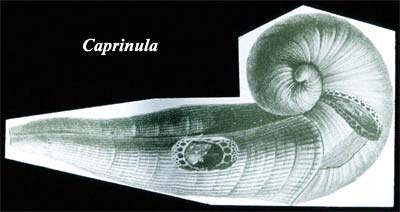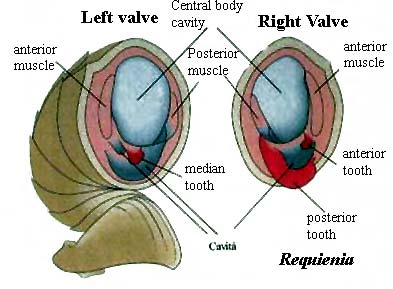
| Palaeos: Mesozoic |  |
Early Cretaceous |
| Cretaceous Period | Aptian Age |
| Page Back | Back: Barremian | Back: Early Cretaceous I | Up: Early Cretaceous II | Unit Home |
| Page Next | Next: Albian | Next: Late Cretaceous I | Timescale |
|
Cretaceous Early Cretaceous I (Neocomian) Valanginian Age Early Cretaceous II (Aptian-Albian) Aptian Age Late Cretaceous Santonian Age |
The Aptian Aptian Reefs |
![]() The Aptian was a long age, the second-longest of the Mesozoic. It was
also an eventful time. Unlike some geological ages, it is not at all
difficult to find important events in the Aptian. A spike occurred in an
already rapid rate of ocean spreading in the Atlantic. This, for the first
time, opened the Atlantic Ocean wide enough to allow significant mixing of
waters across the equator. This is associated, in some as-yet undetermined
manner, with: (a) the first in a series of Ocean Anoxic Events which extended into
the Santonian, and (b) with a probable massive release
of methane about 117 Mya. This last event -- or something else -- caused a dramatic increase in
temperatures in the mid-Aptian (Jenkyns
& Wilson, 1999), and a significant turnover of land fauna in the Late Aptian and
across the Aptian-Albian boundary. The Aptian saw the first ceratopsians,
almost the last stegosaurs,
the enormous Sauroposeidon
and the diminutive Gobiconodon,
the simultaneous evolution of the first of the swift, unarmored iguanodont-
hadrosaur group, and the definitive members of nature's ultimate tanks, the
nodosaurs.
The Aptian was a long age, the second-longest of the Mesozoic. It was
also an eventful time. Unlike some geological ages, it is not at all
difficult to find important events in the Aptian. A spike occurred in an
already rapid rate of ocean spreading in the Atlantic. This, for the first
time, opened the Atlantic Ocean wide enough to allow significant mixing of
waters across the equator. This is associated, in some as-yet undetermined
manner, with: (a) the first in a series of Ocean Anoxic Events which extended into
the Santonian, and (b) with a probable massive release
of methane about 117 Mya. This last event -- or something else -- caused a dramatic increase in
temperatures in the mid-Aptian (Jenkyns
& Wilson, 1999), and a significant turnover of land fauna in the Late Aptian and
across the Aptian-Albian boundary. The Aptian saw the first ceratopsians,
almost the last stegosaurs,
the enormous Sauroposeidon
and the diminutive Gobiconodon,
the simultaneous evolution of the first of the swift, unarmored iguanodont-
hadrosaur group, and the definitive members of nature's ultimate tanks, the
nodosaurs.
Image: Gobiconodon from Validosta State University's Virtual Museum of Fossils.
ATW040915. Text public domain; no rights reserved.
 Aptian
reefs were typically composed of rudists. In spite of their name, rudists
were probably no less civil than the scleractinian corals they replaced.
Indeed, it is the rudists who have suffered from a singular lack of courtesy
from ill-bred geologists, who rejoice in pointing out that rudist masses are not
really "reefs." Technically, this may be correct. The
rudists tended to trap sediment between their long, ribbed lower valves, which
stood up from the sea floor like the stalks of some horrible mutant
celery. Thus, rudist reefs were not entirely composed of biogenic
carbonates like a coral reef. They contained substantial amounts of sand and
mud, in addition to encrusting calcareous algae and other oddments. Yet it
is surely impolite to harp on these occasional indiscretions of the distant
past.
Aptian
reefs were typically composed of rudists. In spite of their name, rudists
were probably no less civil than the scleractinian corals they replaced.
Indeed, it is the rudists who have suffered from a singular lack of courtesy
from ill-bred geologists, who rejoice in pointing out that rudist masses are not
really "reefs." Technically, this may be correct. The
rudists tended to trap sediment between their long, ribbed lower valves, which
stood up from the sea floor like the stalks of some horrible mutant
celery. Thus, rudist reefs were not entirely composed of biogenic
carbonates like a coral reef. They contained substantial amounts of sand and
mud, in addition to encrusting calcareous algae and other oddments. Yet it
is surely impolite to harp on these occasional indiscretions of the distant
past.
Rudists were, in fact, aberrant bivalve
mollusks.
Consider an ammonite, or nautiloid. Now, since this is a bivalve, imagine
a creature with two such shells curling in opposite directions, like the horns on
a ram's head. Finally take one (or sometimes both) of the coiled horns and
straighten it out. The result should look something like Caprinula,
shown in the image. The left valve became an elongate stem anchored in the
sea floor. The right valve could take on any number of morphologies --
from a simple,  flat,
operculum (like the "lid" on the exhaust pipe of a diesel truck) to any
one of the peculiar morphologies adopted by
single-shelled mollusks. "Teeth" mounted on the valves
formed the articulation between them. The internal structure, so far as it
has been worked out, was more or less like that of conventional bivalves. See
the image of Requienia. The animal itself occupied only the upper
part of the lower valve, the remainder of the lower section being sealed off with horizontal
partitions.
flat,
operculum (like the "lid" on the exhaust pipe of a diesel truck) to any
one of the peculiar morphologies adopted by
single-shelled mollusks. "Teeth" mounted on the valves
formed the articulation between them. The internal structure, so far as it
has been worked out, was more or less like that of conventional bivalves. See
the image of Requienia. The animal itself occupied only the upper
part of the lower valve, the remainder of the lower section being sealed off with horizontal
partitions.
Rudists diverged from other bivalves some time in the Jurassic. The earliest were Requinidae which were still usually somewhat coiled. The formation of Aptian rudist reefs may have been driven by -- or may have driven -- the evolution of the Capridae, like Caprinula, and other new forms of rudist. This brief bloom of rudist diversity ended before the close of the Aptian-Albian and was not resumed until well into the High Cretaceous. Rudist diversity collapsed during the Maastrichtian, and the entire taxon became extinct at the end of the Mesozoic.
These earlier rudists are frequently associated with other faunal indicators to form a characteristic "Urgonain" facies. In Urgonian deposits, rudists are often found in association with masses of tests from large foraminifera, such as Orbitolina and Choffatella, the presence of which is an indicator of Aptian-Albian age. Lehmann et al. (1999). A well-known example is the reef enclosing the Shuaiba Formation limestone reservoirs of the United Arab Emirates, one of the richest oil-producing systems in the world. Urgonian facies are also characterized, negatively, by the absence of ammonites and belemnites. These absence indicators may simply reflect the fact that these early rudist reefs were usually products of shallow water, or even intertidal, environments.
Corals may also be associated with rudist reefs -- possibly only those reefs far from the equator. It has been argued at some length that equatorial surface waters during the Aptian heat wave approached 30° C. and were lethal to corals. Thus, this first generation of rudist reefs may have gotten its start because the seas were simply too hot for corals to thrive.
Links: Drome and Provence (however, we question the statement that Hippurites was present in the Aptian), Patch reefs in the limestones of the Altamira Formation ... (the formation which also created the canvas for an unknown Late Pleistocene artistic genius) , Bild constratatal (great site on rudists), Hippurites taburnii (more on rudists).
ATW040917. Text public domain. No rights reserved.
| Page Back | Unit Home | Page Up | Page Top | Page Next |